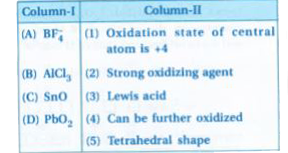Match the species given in Column-I with the properties mentioned in Column-II.

The correct Answer is:A-5 ; B-3 ; C-4 ; D-1,2
(A)In BF−4 , B is sp3 hybridized and surrounded by 4 bond pairs and has no lone pair.
(B) In AlCl3 octet of Al is not complete , electron deficient compound.
(C)In SnO oxidation state of Sn is +2 and can be changed in to +4.
(D) In PbO2 , oxidation state of Pb is +4 , it is less stable due to inert pair effect and +2 oxidation state is more stable . Pb4+ , changes in to Pb2+ acts as a strong oxidizing agent.
Topper's Solved these Questions
- THE P-BLOCK ELEMENTSBOOK - KUMAR PRAKASHANCHAPTER - THE P-BLOCK ELEMENTSEXERCISE - SECTION-D NCERT EXEMPLAR SOLUTION (MCQs) ASSERTION & REASON
2 Videos
- THE P-BLOCK ELEMENTSBOOK - KUMAR PRAKASHANCHAPTER - THE P-BLOCK ELEMENTSEXERCISE - SECTION-D NCERT EXEMPLAR SOLUTION (MCQs) LONG ANSWER
25 Videos
- THE P-BLOCK ELEMENTSBOOK - KUMAR PRAKASHANCHAPTER - THE P-BLOCK ELEMENTSEXERCISE - SECTION-D NCERT EXEMPLAR SOLUTION (MCQs) Short Answer
27 Videos
- STRUCTURE OF ATOMBOOK - KUMAR PRAKASHANCHAPTER - STRUCTURE OF ATOMEXERCISE - QUESTINS PAPER FROM MODULE (SECTION -D)
2 Videos
- THE s-BLOCK ELEMENTSBOOK - KUMAR PRAKASHANCHAPTER - THE s-BLOCK ELEMENTSEXERCISE - Section-D NCERT Exemplar Solution (Long Answer Type)
8 Videos
Similar Questions
Mathc the species given in Column I with the properties mentioned in Column II.

View SolutionMatch the species given in Column I with the properties mentioned in Column II
Column-IColumn-IIA.BF−41.Oxidation state of central atom is +4B.AlCl32.Strong oxidising agentC.SnO3.Lewis acidD.PbO24.Can be further oxidised5.Tetrahedral shape
View SolutionMatch the elements given in column I with the properties mentioned in Column II.

View SolutionMatch the element in Column I with the properties mentioned in Column II

View SolutionMatch the species given in Column I with the hybridstion given in Column II.

View SolutionMatch the compounds given in Column I with their uses mentioned in Column II.
 .
.
View SolutionMatch the species given in column I with prperties given in Column II.

View SolutionMatch the complexes in Column-I with their properties listed in Column-II

View SolutionMatch the complexes in Column-I with their properties listed in Column-II

View SolutionMatch the species given column I with prooperties given in column II

View Solution
